“The true nature of biblically accurate demons and angels, their roles, and appearances as described in the Bible.”
The study of biblically accurate demons and angels offers fascinating insight into the spiritual realm and their roles in biblical teachings. These celestial beings are often misunderstood and misrepresented in modern culture, but when viewed through the lens of scripture, we gain a clearer understanding of their true nature, purpose, and appearance.
In this article, we will explore biblically accurate demons and angels, explaining their characteristics and roles as described in the Bible. We will also address common questions about these spiritual beings, offering a deeper understanding based on scriptural references.
From the angelic hierarchy of seraphim and cherubim to the fall of Lucifer and the realm of fallen angels, these beings are crucial to understanding biblical narrative and spiritual warfare.
It’s important to know about spiritual beings like demons and angels because they shape our beliefs and spiritual practices. The Bible tells us a lot about their roles and functions, from angels as messengers of God to the deceptive nature of demons.
In fact, understanding Bible accurate demons helps us gain a deeper insight into their true nature and their role in influencing human lives. We’ll take a closer look at their influence and representation throughout scripture.
For centuries, people have been interested in demons and angels. By looking at biblical references and their encounters in scripture, we learn about these spiritual beings and the supernatural encounters that occur in the Bible. This helps us understand the spiritual world better and provides clarity on the roles of angels and demons in Christian theology and spiritual warfare.
What is Demonology?
Demonology is the study of demons and their influence on the world. In biblical terms, demons are fallen angels who rebelled against God and now serve to oppose His will. These beings work under the authority of Satan and are often involved in tempting, deceiving, and causing harm to humanity. Their ultimate purpose is to lead people away from God’s truth.
According to the Bible, demons are not just malevolent spirits; they are also described as possessing people, causing physical and mental afflictions, and leading people into sin. Demonology studies how these spirits operate, their origins, and their ultimate fate.
Scripture:
Ephesians 6:12 states, “For we do not wrestle against flesh and blood, but against rulers, against the authorities, against the cosmic powers over this present darkness, against the spiritual forces of evil in the heavenly places.”
Prayer:
Heavenly Father, help us to recognize the spiritual forces that work against us and give us the strength to stand firm in our faith. Protect us from the schemes of the enemy and guide us to live according to Your will. In Jesus’ name, Amen.
Who is the Famous Demon in the Bible?
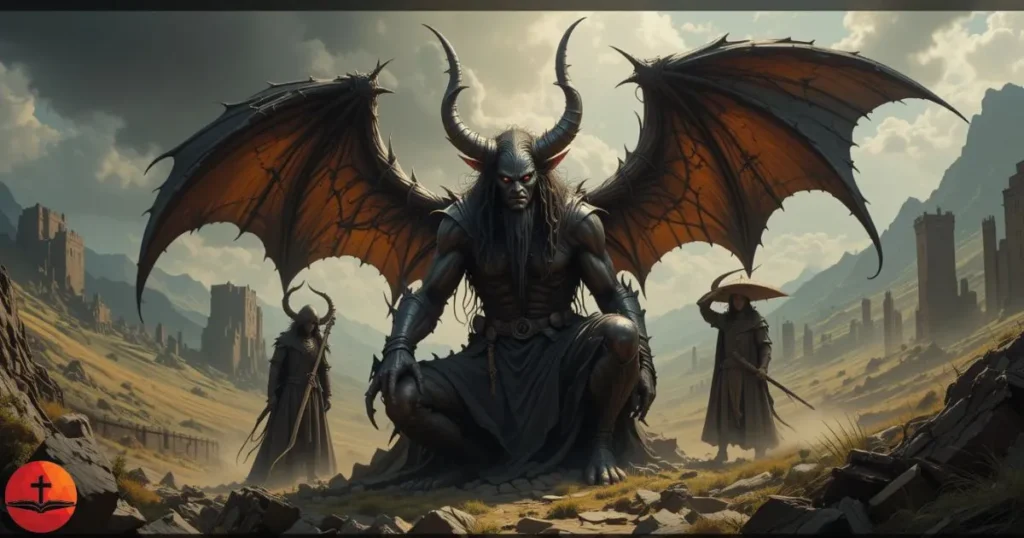
In the Bible, the most famous demon is Satan. Often referred to as the “adversary,” Satan was originally an angel created by God but fell from grace. He is commonly known for his rebellion against God. His story begins in the book of Isaiah and is further explored in Ezekiel, but it becomes most prominent in the New Testament.
Satan is depicted as the tempter who tries to lead humans away from God. He played a major role in the temptation of Adam and Eve in the Garden of Eden, persuading them to sin by eating the forbidden fruit. His ultimate goal is to oppose God’s plan for humanity, and he is often shown as the enemy of good.
Beyond Satan, other demons appear in the Bible, often associated with temptation, evil spirits, or possessing individuals. These demons are under Satan’s influence, and they serve as reminders of the spiritual battle between good and evil.
Good Demons in the Bible

While demons are typically associated with evil, the Bible also presents angels divine beings who act as messengers of God. It is important to note that angels are often seen as the “good” counterparts to demons.
There are a few instances where the Bible describes supernatural beings that could be mistaken for demons, but they actually serve positive purposes. For example, fallen angels are often seen as rebellious, but the term “angel” in the Bible refers to messengers who bring God’s message to His people.
An interesting case is Gabriel, an angel who appears throughout the Bible. While not considered a demon, Gabriel plays a vital role in delivering God’s word and guiding humans toward righteousness.
In a broader sense, the Bible encourages Christians to be aware of spiritual forces if good or evil that are constantly influencing the world. By understanding these influences, believers can better navigate life with faith and purpose.
Names of Biblically Accurate Demons
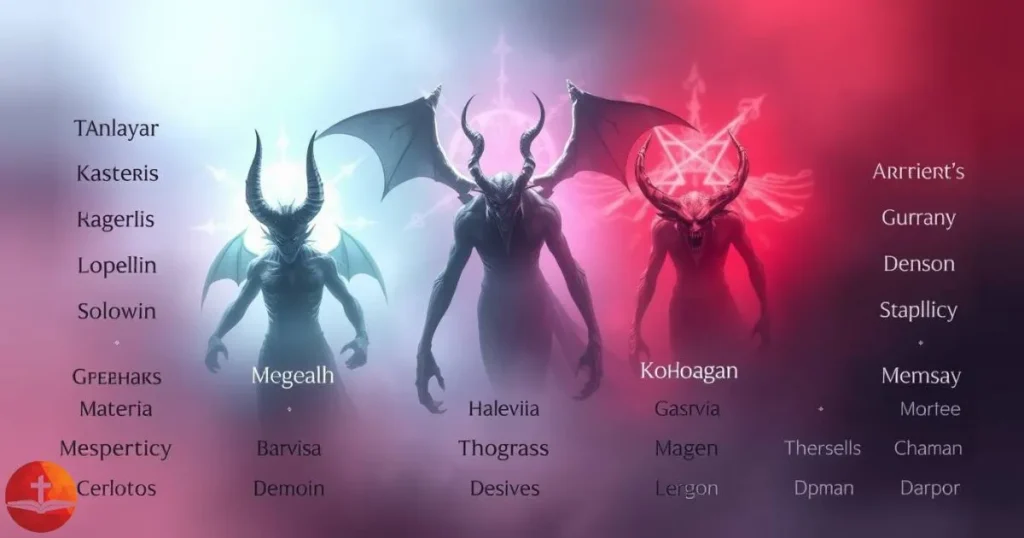
The Bible does not list many demon names, but it mentions a few key ones. Demons are fallen angels who followed Satan in rebellion. Some significant names include:
- Lucifer (Satan) – The leader of the fallen angels (Isaiah 14:12).
- Beelzebub – Known as the “Lord of the Flies” (Matthew 12:24).
- Abaddon (Apollyon) – The “Destroyer” (Revelation 9:11).
- Legion – A group of demons possessing a man (Mark 5:9).
Scripture:
- Ephesians 6:12 – “For we do not wrestle against flesh and blood, but against principalities, against powers, against the rulers of the darkness of this age, against spiritual hosts of wickedness in the heavenly places.”
- 2 Corinthians 11:14 – “And no wonder! For Satan himself transforms himself into an angel of light.”
Prayer:
“Lord, I take authority over every unclean spirit that seeks to deceive or harm me. By the blood of Jesus, I renounce all demonic influence and stand firm in Your truth. Amen.”
Appearance of Biblically Accurate Demons

Unlike modern depictions, Biblical demons do not always have grotesque forms. Instead, they often disguise themselves as something appealing to deceive people. Some are described as “unclean spirits” (Mark 1:23) or as “fallen stars” (Revelation 9:1).
Scripture:
- Luke 10:18 – “And He said to them, ‘I saw Satan fall like lightning from heaven.’”
- Revelation 16:13-14 – “And I saw three unclean spirits like frogs coming out of the mouth of the dragon, out of the mouth of the beast, and out of the mouth of the false prophet.”
Prayer:
“Father, help me to discern between truth and deception. Keep my eyes open so that I may not be led astray by the schemes of the enemy. In Jesus’ name, Amen.”
Biblically Accurate Demons in Art

Historical and religious art depicts demons in various ways, sometimes as dark, twisted creatures or as beings of deceptive beauty. Early Christian art often showed demons as dark figures with grotesque features, while some medieval art showed them as monstrous beings with wings and horns.
Scripture:
- 2 Corinthians 11:13-15 – “For such are false apostles, deceitful workers, transforming themselves into apostles of Christ. And no wonder! For Satan himself transforms himself into an angel of light.”
- Matthew 25:41 – “Then He will also say to those on the left hand, ‘Depart from Me, you cursed, into the everlasting fire prepared for the devil and his angels.’”
Prayer:
“Lord, I reject the images that glorify darkness and deception. Let my mind be filled with things that are pure and righteous. Keep me focused on Your light. Amen.”
Biblically Accurate Angels vs. Biblically Accurate Demons

Angels and demons are both spiritual beings, but angels serve God, while demons rebel against Him. Angels are often described as powerful messengers with overwhelming glory, while demons are depicted as deceptive, destructive, and fallen beings.
| Biblically Accurate Angels | Biblically Accurate Demons |
| Serve and worship God (Psalm 103:20) | Oppose God and deceive people (1 Timothy 4:1) |
| Appear in brilliant light (Daniel 10:6) | Can disguise themselves as light (2 Corinthians 11:14) |
| Protect and minister to believers (Hebrews 1:14) | Torment and deceive (Revelation 12:9) |
Scripture:
- Hebrews 1:14 – “Are they not all ministering spirits sent forth to minister for those who will inherit salvation?”
- Revelation 12:9 – “So the great dragon was cast out, that serpent of old, called the Devil and Satan, who deceives the whole world.”
Prayer:
“Lord, I thank You for Your heavenly angels who fight on my behalf. I pray that You send them to guard and protect me from all the powers of darkness. In Jesus’ name, Amen.”
Are Biblically Accurate Demons Beautiful?

Some demons can appear beautiful to deceive, while others manifest as horrific beings. The Bible warns that Satan can disguise himself as an angel of light (2 Corinthians 11:14). This means demons do not always appear as horrifying creatures but may look attractive or harmless to lure people into sin.
Scripture:
- Genesis 3:1 – “Now the serpent was more cunning than any beast of the field which the Lord God had made.”
- 2 Thessalonians 2:9-10 – “The coming of the lawless one is according to the working of Satan, with all power, signs, and lying wonders.”
Prayer:
“Father, protect me from deception. Open my eyes to see the truth and guard my heart against the lies of the enemy. Let me seek only what is holy and good. In Jesus’ name, Amen.”
Types of Demons in the Bible
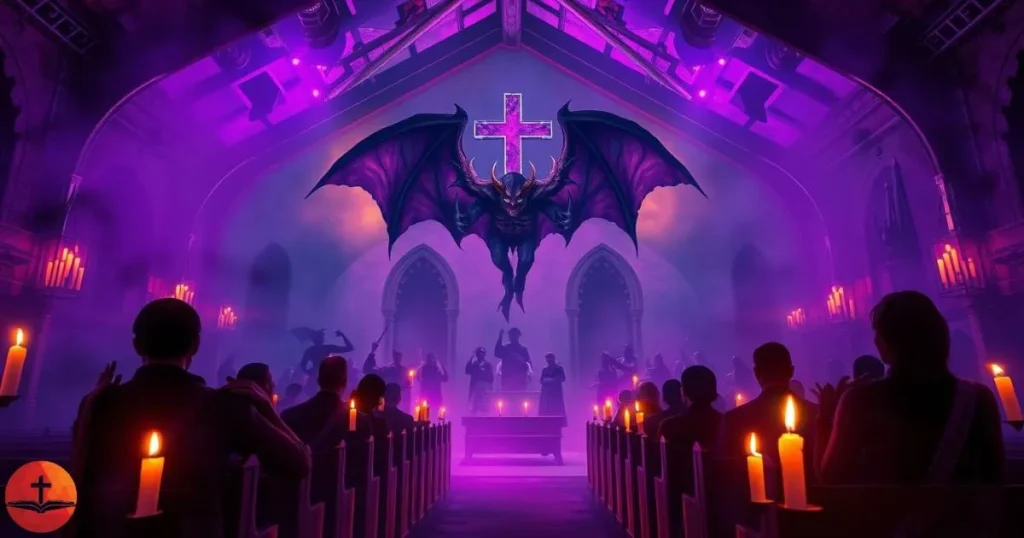
Fallen Angels
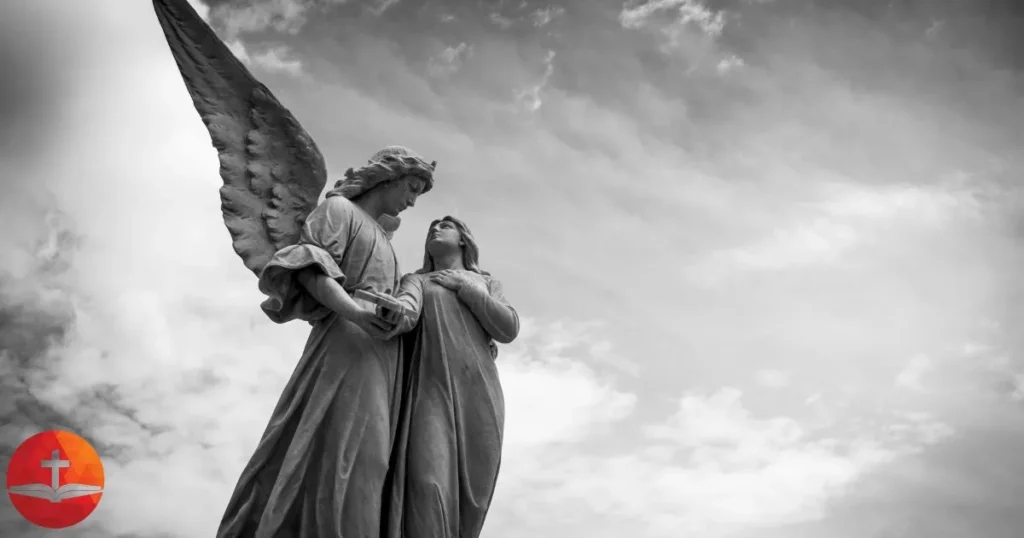
These demons were once angels of God but were cast out of heaven due to their rebellion against Him. They are now agents of Satan, working to oppose God’s work in the world.
Unclean Spirits
These demons are described as evil entities that can possess people and cause physical or mental afflictions. They are often seen in the Bible as causing sickness and torment.
Deceiving Spirits
These demons are known for spreading lies and false teachings to mislead believers and non-believers alike. They distort truth and bring confusion.
Principalities and Powers

These demons operate in high spiritual realms, influencing governments, institutions, and large-scale societal systems to promote evil. They are powerful entities that often work behind the scenes to create chaos.
Scripture:
Revelation 12:7-9 says, “Now war arose in heaven, Michael and his angels fighting against the dragon. And the dragon and his angels fought back, but he was defeated, and there was no longer any place for them in heaven.”
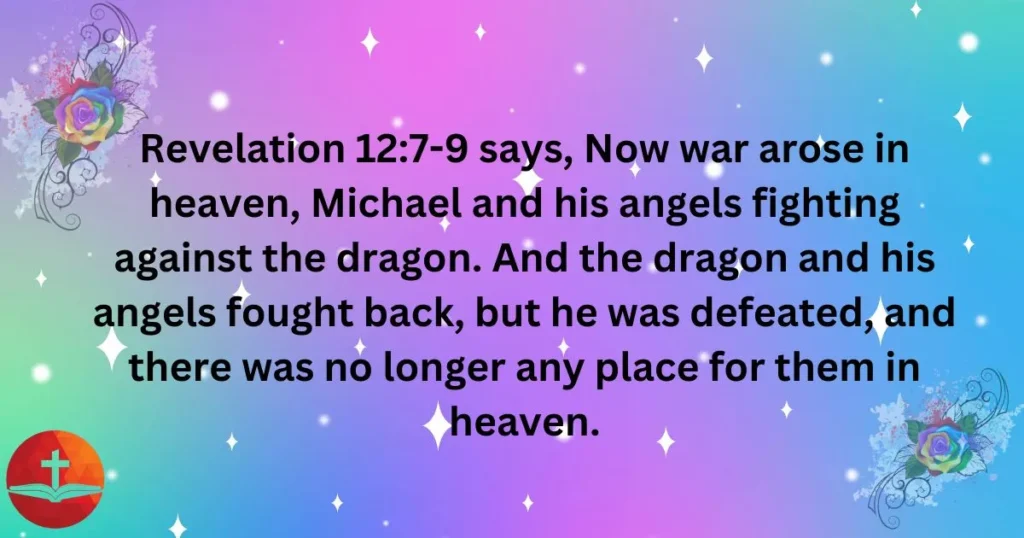
Prayer:
Lord, we ask for Your protection from the forces of darkness that seek to undermine Your will. Give us the wisdom and strength to resist the enemy and remain steadfast in faith. In Jesus’ name, Amen.
A List of Demons According to the Bible
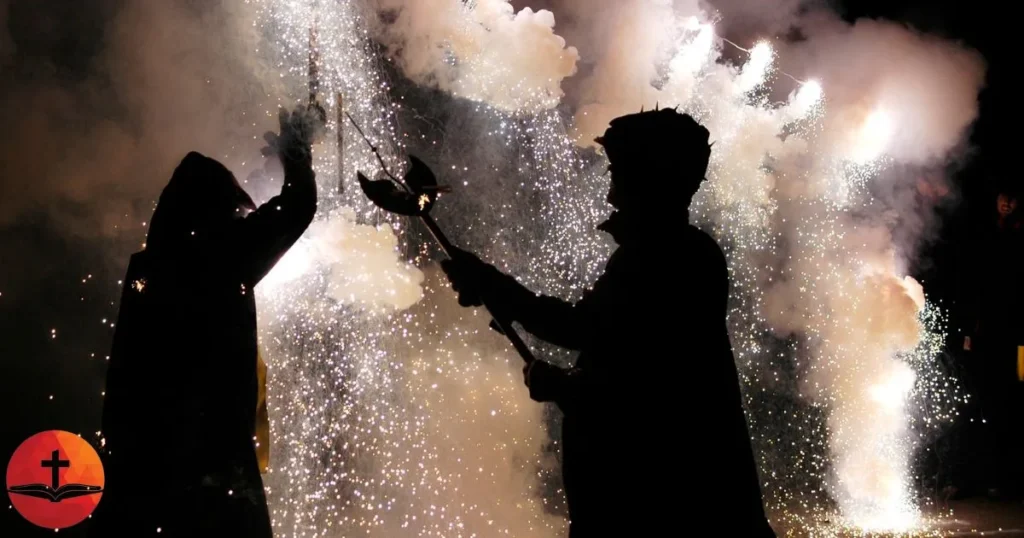
The Bible mentions various demons, some by name and others by their roles or characteristics. Some well-known demons mentioned in scripture include Beelzebul, often identified as the lord of the flies or the prince of demons, and Legion, a group of demons that possessed a man in the region of the Gerasenes. These demons are associated with torment, deception, and causing division.
Scripture:
Mark 5:9 says, “And Jesus asked him, ‘What is your name?’ He replied, ‘My name is Legion, for we are many.'”
Prayer:
Father, help us to always remember that no matter how many demons may oppose us, Your power is greater. Keep us safe from the forces that seek to harm us. We trust in Your protection. Amen.
What Does the Devil Look Like?
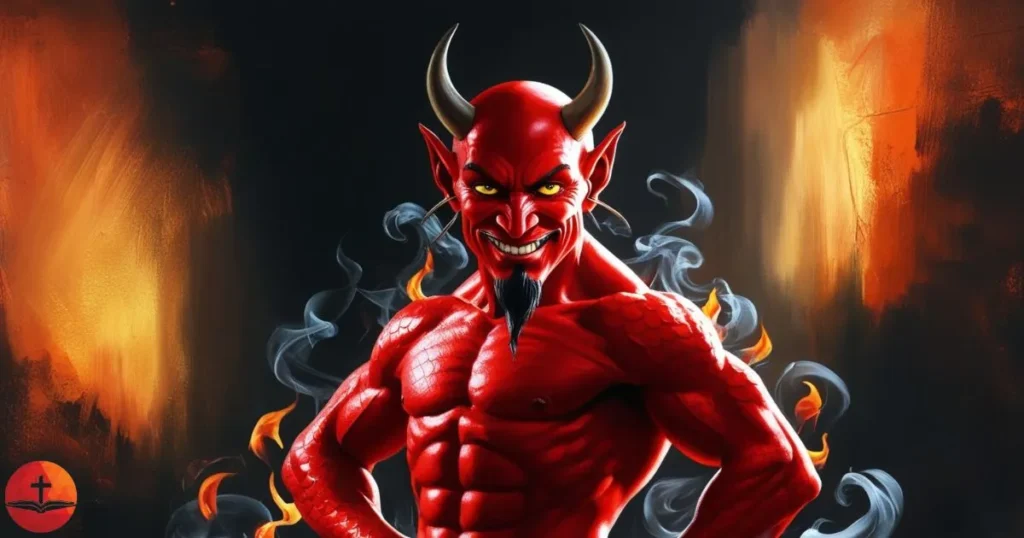
In the Bible, the devil, also known as Satan, is often described as a deceiver and a tempter. Although there are no specific descriptions of Satan’s physical appearance, he is sometimes depicted symbolically, as a serpent or as an angel of light. The Bible warns that Satan can appear as something attractive, masking his true nature to deceive people into sin.
Scripture:
2 Corinthians 11:14 says, “And no wonder, for even Satan disguises himself as an angel of light.”
Prayer:
Lord, protect us from the deceptions of Satan. Help us to recognize his lies and stand firm in Your truth. Strengthen us to resist temptation and remain faithful to You. In Jesus’ name, Amen.
Shocking Bible Verses You Won’t Believe Exist!
What Do Angels Look Like?

Angels, according to the Bible, are spiritual beings who serve God and act as messengers, protectors, and warriors. While angels can appear in different forms, they are often described as radiant, glowing beings with great power and beauty. They are sometimes depicted with wings, but the Bible also mentions that some angels appear in human form.
Scripture:
Daniel 10:6 describes an angel: “His body was like beryl, his face like the appearance of lightning, his eyes like flaming torches, his arms and legs like the gleam of burnished bronze, and the sound of his words like the sound of a multitude.”
Prayer:
Heavenly Father, thank You for sending Your angels to protect and guide us. Help us to recognize Your presence in our lives and trust in Your protection. In Jesus’ name, Amen.
Types of Angels
Seraphim

The Seraphim are angels who are in close proximity to God’s throne. They are described as having six wings and continuously worshiping God, declaring, “Holy, holy, holy is the Lord God Almighty.”
Cherubim

The Cherubim are guardians of God’s holiness. They are often depicted with multiple wings and are stationed at the entrance to the Garden of Eden, guarding the way to the tree of life.
Archangels
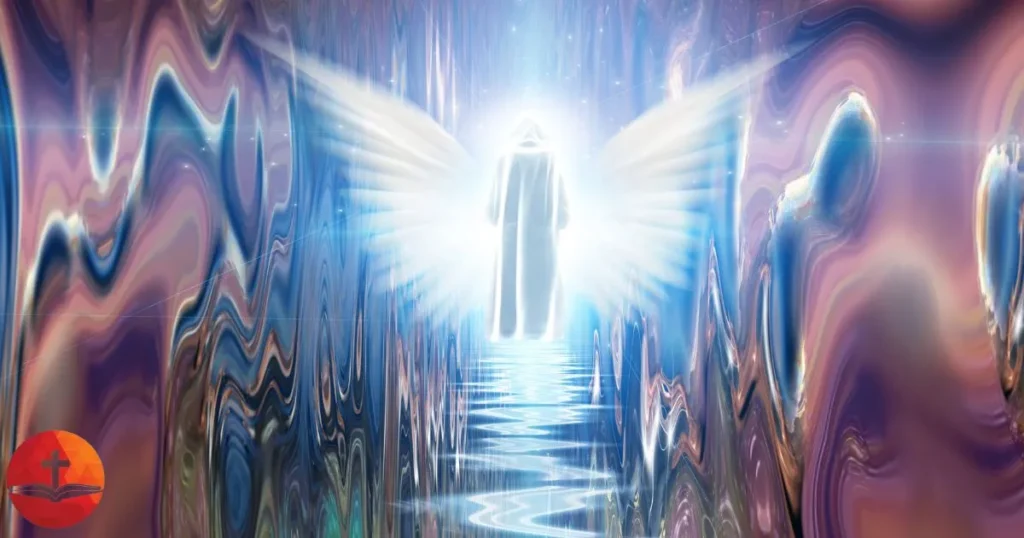
Archangels are high-ranking angels who carry out God’s commands. Michael, for example, is described as an archangel who leads God’s army in spiritual warfare.
Angels of the Lord
These angels are sent by God to deliver messages or to perform specific tasks. They are often sent to guide, protect, or provide for God’s people.
Scripture:
Isaiah 6:2-3 describes the Seraphim: “Above him stood the seraphim. Each had six wings: with two he covered his face, and with two he covered his feet, and with two he flew. And one called to another and said: ‘Holy, holy, holy is the Lord of hosts; the whole earth is full of His glory.'”
Prayer:
Lord, we thank You for the angels You send to help and protect us. May we feel Your presence and be reminded of Your constant care and guidance. In Jesus’ name, Amen.
Key Differences Between Angels and Demons
| Aspect | Angels | Demons |
|---|---|---|
| Origins | Believed to be created by divine powers to serve and protect. | Often depicted as fallen beings or spirits opposing divine will. |
| Symbolism | Represent light, purity, hope, and goodness. | Symbolize darkness, temptation, chaos, and evil. |
| Purpose | Serve as messengers, guides, and protectors of humanity. | Aim to mislead, corrupt, or harm humans. |
| Depictions | Shown with wings, glowing light, and peaceful expressions. | Portrayed as shadowy, monstrous, or fiery beings with intimidating forms. |
| Influence on Humans | Inspire acts of kindness, faith, and courage. | Encourage fear, selfishness, and immoral behavior. |
What is the difference between a biblically accurate angel and a biblically accurate demon?
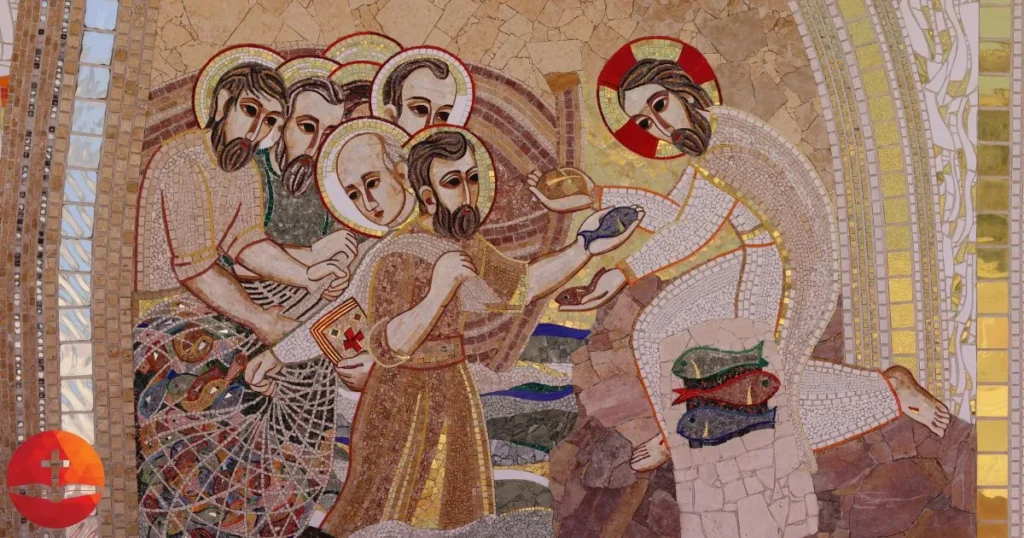
Biblically accurate angels are described as holy, awe-inspiring beings serving God’s will, often appearing with multiple wings, eyes, or as flames of fire. In contrast, demons are fallen angels, depicted as rebellious, malevolent spirits seeking to corrupt and oppose God’s plans. While angels inspire worship and reverence, demons evoke fear and temptation.
How Were Demons Described in the Bible?
The Bible portrays demons as unclean spirits, formerly angels, who rebelled with Satan. They cause oppression, illness, and deceit, often appearing in association with idolatry and sin. Their ultimate fate is destruction in the lake of fire.
What Does the Bible Say About Angels and Demons?
The Bible highlights angels as messengers and protectors of God’s people, while demons serve as agents of evil under Satan’s command. Both operate in the spiritual realm, reflecting the cosmic battle between good and evil.
Bible Verses About Angels
Angels are mentioned throughout the Bible as messengers of God and beings of spiritual significance. Some key verses include:
- Psalm 91:11 – “For He will command His angels concerning you to guard you in all your ways.”
- Hebrews 1:14 – “Are not all angels ministering spirits sent to serve those who will inherit salvation?”
- Luke 2:13-14 – “Suddenly a great company of the heavenly host appeared with the angel, praising God.”
- Isaiah 6:2 – “Above him stood the seraphim. Each had six wings: with two he covered his face, with two he covered his feet, and with two he flew.”
Illustrations of Angels
In art and culture, angels are often depicted with:
- Wings: Signifying their celestial nature and their ability to move between heaven and earth.
- Radiance: A glow or aura symbolizing their connection to God’s glory.
- Swords: Representing their role as protectors or warriors (e.g., Archangel Michael in Revelation 12:7).
- Humanoid Form: Many times, angels are portrayed in a human-like appearance but with an otherworldly beauty.
Biblical Descriptions of Angels
The Bible provides vivid descriptions of angels. For instance:
- Cherubim – Described as having multiple wings and the appearance of a lion, ox, man, or eagle (Ezekiel 10:14).
- Seraphim – Mentioned in Isaiah 6, they have six wings and sing praises, “Holy, holy, holy is the Lord Almighty.”
- Archangels – Michael and Gabriel are explicitly named and serve as messengers or warriors (Daniel 10:13, Luke 1:26).
- Heavenly Hosts – Often described as countless beings praising God in unison (Revelation 5:11).
The Appearance of Angels
Angels can appear in various forms:
- Human-Like: When interacting with people, they often appear as ordinary humans (Genesis 18:2).
- Glorious Forms: Their divine nature may shine through, as seen in Matthew 28:3: “His appearance was like lightning, and his clothes were white as snow.”
- Fearsome: Their grandeur often induces fear, prompting angels to say, “Do not be afraid” (Luke 2:10).
What About Guardian Angels?
The concept of guardian angels is supported by several biblical passages, though it isn’t elaborated on extensively.
- Matthew 18:10 – “See that you do not despise one of these little ones. For I tell you that their angels in heaven always see the face of my Father in heaven.”
- Psalm 34:7 – “The angel of the Lord encamps around those who fear him, and he delivers them.”
While the Bible suggests angels are sent to protect and guide believers, the idea of each person having a specific guardian angel is more of a theological interpretation than an explicit biblical teaching.
Are demons fallen angels?
The concept of demons as fallen angels originates primarily from religious texts, theological interpretations, and cultural beliefs. The idea varies depending on the tradition or faith in question:
In Christianity:
Yes, demons are often understood as fallen angels. This belief is based on interpretations of the Bible, particularly passages like Isaiah 14:12-15 and Revelation 12:7-9. According to these, Lucifer, a high-ranking angel, rebelled against God and was cast out of Heaven along with other angels who followed him. These fallen angels became demons, serving evil and opposing God.
- Lucifer’s fall is often associated with pride and a desire to become like God.
- Demons’ role in this narrative is to tempt humans and lead them away from righteousness.
In Islam:
Islam also speaks of rebellious beings, but the concept is slightly different. Jinn are a separate creation made from smokeless fire, distinct from angels (created from light). While angels are inherently obedient to God, Iblis (Satan), a Jinn, refused to bow to Adam and was cast out of favor. Some interpret Iblis and other rebellious Jinn as equivalent to demons, but they are not considered fallen angels since Jinn are a different creation altogether.
In Other Belief Systems:
- In Judaism, the concept of demons (or shedim) exists but is not as explicitly tied to fallen angels as in Christianity. Instead, demons may be viewed as spirits or supernatural entities with varying roles and origins.
- In mythology and folklore, demons are often described as malevolent spirits but may not be connected to the concept of angels at all.
Modern Interpretations:
In modern contexts, the association between demons and fallen angels is common in popular culture, literature, and media. However, not all interpretations tie them directly to angelic rebellion.
Understanding Celestial Hierarchies
The idea of heaven and hell comes from the Bible. These places are home to many spiritual beings. Each one has its own job and place in the sky.
The Bible shows us a detailed setup of these beings. We see angels, archangels, and others, each with their own tasks. Heaven is seen as a place of divine presence. Here, spiritual beings talk to the divine and do its will. On the other hand, hell is a dark place, far from the divine.
- Different levels of spiritual beings, each with unique roles and responsibilities
- The interaction between spiritual beings and the divine in the heaven
- The concept of hell as a realm of darkness and separation from the divine
Looking into the Bible helps us understand the spiritual beings in these places. We learn about their roles in the universe. This knowledge gives us insights into heaven and hell and how they relate to the divine.
1. Angels and Demons Bible Study
A Bible study on angels and demons typically examines the roles and nature of these spiritual beings as described in Scripture. In Christian belief, angels are messengers and servants of God, while demons are fallen angels or spiritual beings that work against God’s purposes.
Key themes explored in such a study may include the creation of angels (Ezekiel 28:12-19), their roles in the spiritual realm (Hebrews 1:14), the rebellion of Lucifer (Isaiah 14:12-15), and the ongoing spiritual warfare between good and evil (Ephesians 6:12).
2. Biblically Accurate Demons
In the Bible, demons are typically seen as malevolent spiritual beings. They are often associated with Satan, who was originally an angel created by God but fell from grace. Demons are portrayed as causing physical and spiritual harm to people, oppressing, tempting, and leading them away from God.
A key aspect of demons in biblical teachings is their role in the temptation of humanity (Matthew 4:1-11) and their influence in creating chaos (Mark 5:1-20).
3. What Do Biblically Accurate Demons Look Like?
While the Bible does not give a clear, detailed description of the physical appearance of demons, they are often depicted in Scripture as spiritual beings that can possess or influence humans and animals. In some cases, they are described as unclean spirits or evil spirits (Luke 8:29).
There are also symbolic references, such as in Revelation 9, where demons are described with features like locusts, scorpions, or horses, emphasizing their destructive and terrifying nature. The emphasis in the Bible is more on their actions and influence rather than their appearance.
4. Biblically Accurate Angels Explained
Angels, in biblical teachings, are spiritual beings created by God to serve Him and carry out His will. They are often described as appearing in human form or as majestic, powerful beings, sometimes shining with light.
In the Bible, angels serve as messengers, warriors, and guides for God’s people. Notable angelic appearances include the archangel Michael (Jude 1:9), Gabriel (Luke 1:26-38), and the seraphim and cherubim who surround God’s throne (Isaiah 6:1-4, Ezekiel 10:1-14).
Biblically accurate angels can have multiple wings (Isaiah 6), and they are often depicted as intimidating, with some messages requiring human beings to “not be afraid” (Luke 1:30).
5. What Are the 7 Levels of Demons?
The concept of “7 levels of demons” is not explicitly found in the Bible. However, certain interpretations and extra-biblical traditions, including in some branches of Christianity and occult beliefs, describe demons in hierarchical structures. In these traditions, demons are categorized based on their power, role, or authority. For example:
- Principalities: High-ranking demons, often associated with nations and governments.
- Powers: Demons responsible for controlling the elements, nature, and various forces of evil.
- Rulers of Darkness: Demons that focus on spreading ignorance, lies, and deception.
- Spiritual Wickedness: Demons that work in spiritual realms to corrupt faith and religious practices. However, these distinctions come from interpretations outside of the Bible and should be understood as non-canonical. The Bible itself doesn’t provide a detailed, structured list of “levels” for demons.
The Definition of Angels in the Bible
In the Bible, angels are described as spiritual beings created by God to serve as messengers and agents of His divine will. The term “angel” originates from the Greek word angelos and the Hebrew word mal’akh, both meaning “messenger.” Angels act as intermediaries between God and humanity, delivering messages, protecting individuals, and executing God’s judgments.
Key characteristics of angels in the Bible:
- Spirit Beings: Angels are not bound by physical form but can assume human appearance when needed (Hebrews 1:14).
- Divine Servants: They exist to glorify and obey God (Psalm 103:20).
- Mediators of God’s Will: They communicate God’s plans and intervene in significant events (Luke 1:26–38).
Examples of angelic roles include:
- Protecting Daniel in the lions’ den (Daniel 6).
- Announcing Jesus’ birth to Mary and the shepherds (Luke 1:26, Luke 2:8–14).
The Definition of Demons in the Bible
Demons are described in the Bible as fallen angels who rebelled against God, following Lucifer (Satan), their leader (Isaiah 14:12–15, Revelation 12:7–9). Unlike angels, demons are agents of chaos, deceit, and destruction, opposing God’s purposes.
Key aspects of demons in the Bible:
- Rebellious Spirits: Demons are angels who chose disobedience, aligning themselves with Satan (Matthew 25:41).
- Deceivers: Their primary goal is to lead people away from God through lies and temptation (John 8:44).
- Oppressors: Demons often afflict individuals, as seen in instances of demonic possession in the New Testament (Mark 5:1–20).
Demons’ actions reflect their opposition to God, often creating suffering and temptation to undermine His kingdom.
Demons in the Bible
The Bible provides multiple references to demons and their influence:
Old Testament References:
Demons are sometimes linked to idolatry (Deuteronomy 32:17).
Evil spirits, like the one that tormented King Saul, appear (1 Samuel 16:14).
New Testament Insights:
Jesus frequently cast out demons, demonstrating His authority over them (Matthew 8:28–34, Mark 1:23–26).
Demons recognize Jesus as the Son of God and fear Him (Mark 3:11).
Through the Bible, demons are portrayed as entities working to oppose God’s plans but ultimately defeated through Christ’s victory on the cross (Colossians 2:15).
God’s Will: Demons and Angels in the Bible
The interplay between demons and angels serves a central purpose in revealing God’s sovereignty:
God’s Sovereignty Over Angels and Demons:
Angels act in full obedience to carry out God’s will (Psalm 103:20).
Demons, though rebellious, cannot act outside the boundaries set by God (Job 1:12).
God’s Purpose in Allowing Conflict:
Spiritual battles, such as the one described in Ephesians 6:12, remind believers of their dependence on God.
God uses angels to protect and guide His people, while demons test faith and character, ultimately bringing believers closer to God (James 1:2–3).
The Ultimate Victory:
God’s plan culminates in the defeat of Satan and his demons, as outlined in Revelation 20:10.
Angels rejoice in God’s triumph, affirming His eternal reign (Revelation 7:11–12).
What Biblically Accurate Angels Look Like
Biblically accurate angels, as described in the Bible, are quite different from the common depictions we see in modern art. Instead of looking like human figures with wings, they are often portrayed with multiple eyes, faces, or even having a complex form. For example:
- Seraphim: Described in Isaiah 6:2, they have six wings—two cover their faces, two cover their feet, and two are used for flying.
- Cherubim: Found in Ezekiel 10:1-14, they are depicted with multiple wings, multiple faces (such as that of a human, lion, ox, and eagle), and are often associated with the throne of God.
- Living Creatures: In Revelation 4:6-8, the creatures around God’s throne have six wings and are full of eyes, and each has a different face resembling a lion, an ox, a man, and an eagle.
These descriptions are symbolic, suggesting their extraordinary nature, power, and closeness to God, rather than typical human-like angels.
What Are Biblically Accurate Angels?
Biblically accurate angels are messengers and agents of God, often appearing in a form that transcends human understanding. These angels are not gentle, ethereal beings as often depicted in art. Instead, they are powerful spiritual beings that serve as warriors, servants, or messengers of God.
The Bible frequently describes angels as having a majestic and overwhelming presence—so much so that people often fell to their knees in fear upon seeing them. Some of the most famous types of angels in the Bible include:
- Archangels like Michael and Gabriel, who carry out significant roles in spiritual battles and delivering messages to humans.
- Angels of destruction, like the one who destroyed Sodom and Gomorrah (Genesis 19).
- Guardian angels, who protect and guide individuals, such as mentioned in Psalm 91:11.
Are Biblically Accurate Angels Good?
Yes, biblically accurate angels are generally good, as they are messengers and servants of God. Their actions always serve the will of God, and they act to protect, guide, and deliver God’s messages. However, they can also appear in forms that might seem terrifying or overwhelming because of their power and the seriousness of their missions.
Some biblical angels are involved in executing judgment (e.g., the angel who struck down the Assyrian army in 2 Kings 19:35), but even these actions are in service to God’s plan. So, while they can appear fearsome or dangerous, they are always aligned with the goodness and justice of God.
In the broader narrative, angels are seen as part of God’s divine order and not entities that act out of their own will.
What Do Cherubim, Seraphim, and Other Angels Look Like?
In the Bible, angels are described in ways that differ greatly from the common depictions of winged, human-like figures often seen in modern culture. Let’s take a closer look at cherubim, seraphim, and other types of angels based on biblical descriptions:
- Cherubim: These angels are often associated with guarding important areas, such as the Garden of Eden and the Ark of the Covenant. In Ezekiel 10:1-22, cherubim are described as having four faces—a human face, a lion’s face, an ox’s face, and an eagle’s face—and four wings. They also have hands like a man’s under their wings. Their appearance is intimidating and majestic, symbolizing the divine protection they provide.
- Seraphim: Found in Isaiah 6:1-7, the seraphim are angelic beings that stand in the presence of God, offering eternal praise. The term “seraphim” comes from the Hebrew root meaning “to burn,” suggesting they have a fiery, radiant appearance. They are described as having six wings: two to cover their face, two to cover their feet, and two to fly. They are constantly praising God with the words “Holy, holy, holy is the Lord of hosts.”
- Other Angels: While archangels like Michael and Gabriel are sometimes described as human-like, they too have supernatural qualities. The Bible often notes that angels are messengers of God, so their appearance can vary depending on their mission. For instance, angels often appear as men in the Bible, as seen in Genesis 18 where three visitors (angels) come to Abraham in human form.
These descriptions show that angels in the Bible are not simply human-like beings with wings. They have complex forms, often conveying mystery and divine power, and their appearance reflects their role in God’s heavenly kingdom.
What Do Angels Do and Why It Matters
Angels play a vital role in the spiritual realm as messengers, protectors, and warriors. Here’s a look at what they do according to the Bible:
- Messengers of God: One of the most common roles of angels is to act as messengers. In Luke 1:26-38, the angel Gabriel delivers the message to Mary that she will give birth to Jesus, fulfilling God’s plan. In Daniel 9:21-23, the angel Gabriel again serves as a messenger, explaining visions to Daniel. Their role in delivering God’s will is essential in guiding people toward God’s purposes.
- Protectors: Angels are often depicted as protectors of individuals and nations. In Psalm 91:11, it is written, “For He will command His angels concerning you to guard you in all your ways.” This illustrates the role of angels in guarding the faithful, watching over them, and providing spiritual protection.
- Warriors: Angels are also involved in spiritual battles. In Revelation 12:7-9, the archangel Michael and his angels fight against the forces of evil, led by Satan. The battle between good and evil is an ongoing spiritual struggle, with angels playing an integral role in defending God’s kingdom.
- Worshipers of God: Angels are constantly engaged in praise and worship. In Revelation 4:8, the four living creatures and the twenty-four elders worship God, and seraphim in Isaiah 6 are depicted as singing, “Holy, holy, holy is the Lord of hosts.” Worship is at the core of their existence, highlighting their devotion to God.
- Guides for Believers: Angels can also guide and lead believers in moments of uncertainty or danger. In Acts 12:7-10, an angel frees Peter from prison, guiding him to safety. Angels are portrayed as helpful beings who lead people toward God’s plans and protection.
Why It Matters
Understanding the role of angels in the Bible matters because they are integral to the spiritual world and God’s divine plan. By studying biblically accurate angels, we gain insight into their purpose of guiding, protecting, and worshiping God. This knowledge also enhances our understanding of spiritual warfare and the ongoing battle between good and evil.
In a world often distracted by superficial depictions of angels, it’s essential to return to scripture to grasp their true nature. This not only enriches our understanding of their roles in the Bible, but also reminds us of their ongoing influence in the spiritual realm and their connection to God’s will for humanity.
Biblically Accurate Demon Drawing
Biblically accurate depictions of demons differ significantly from the common portrayals in popular media. In the Bible, demons are spiritual beings who were cast out of Heaven due to rebellion against God. They are often described as unearthly, terrifying, and powerful, sometimes appearing as monstrous creatures or possessing human bodies.
Passages like Revelation 9:7-10 describe them as locust-like creatures with human faces and the ability to cause immense suffering. However, it’s important to remember that the Bible often portrays demons as invisible spiritual forces, with physical manifestations being rare and symbolic.
A biblically accurate demon might not be immediately recognizable in a conventional way, as they are often associated with deception, temptation, and evil. Their true form is spiritual, and they are frequently linked to acts of destruction and influence over sin.
The Bible stresses the importance of resisting evil and recognizing the spiritual battle through prayer and faith in Christ.
Biblically Accurate Jesus
Biblically accurate depictions of Jesus Christ are grounded in Scripture and focus on His spiritual essence and His role as the Savior of humanity. The Bible offers little detail on His physical appearance but emphasizes His divine nature, humility, and compassion.
In Isaiah 53:2, it mentions that Jesus had no beauty or majesty to attract people to Him, and He was despised and rejected. This suggests that His appearance was likely ordinary, without the idealized, glorified features often seen in artistic representations.
The focus of a biblically accurate Jesus lies not on His external features, but on His character and mission. He is portrayed as a servant, full of love, grace, and mercy, healing the sick, teaching about the Kingdom of God, and ultimately sacrificing Himself for the salvation of human being.
His divine nature as the Son of God is affirmed through His miracles, teachings, and resurrection.
Biblically Accurate Demons Appearance
When it comes to biblically accurate demons, the portrayal of these beings in religious texts is far more complex and mysterious than the typical horned figure commonly seen in modern media. According to the Bible, demons do not always fit the classic image of monsters with horns and tails. Instead, their descriptions can be more symbolic and abstract.
In the Bible, demons are often described as spiritual entities without a fixed, physical form. However, there are certain clues that point to their terrifying nature.
For example, in the book of Revelation, there are mentions of beasts and creatures with many eyes, emphasizing their all-seeing and otherworldly qualities. The Book of Ezekiel also offers vivid descriptions of creatures that could be interpreted as demonic, with multiple faces, wings, and wheels within wheels.
These descriptions may seem strange to modern readers, but they highlight the idea that demons are not bound by human logic or form.
Overall, biblically accurate demons are often depicted as having unnatural appearances that challenge our perception of reality. Their forms are alien and unsettling, meant to emphasize their role as agents of chaos and evil, far removed from the familiar world of human beings.
What Do Demons Look Like According to the World?
In contrast to the biblical portrayal of demons, modern interpretations of demons are heavily influenced by cultural depictions seen in movies, TV shows, and literature. Demons in popular culture are often shown as scary monsters with horns, claws, and fiery eyes, which can be traced to medieval and Renaissance art and literature.
Hollywood, in particular, has contributed to this widely accepted image of demons. They are often painted as terrifying monsters that terrorize the living. Movies like The Exorcist and Constantine showcase demons with inhuman features: red skin, sharp teeth, and grotesque faces that elicit fear. These depictions make demons appear as physical threats, which contrasts with their spiritual nature in religious texts.
However, it’s important to note that these portrayals are more influenced by fictional storytelling than by religious doctrine. The popular image of demons is a dramatic reinterpretation meant to create tension and fear. It’s far from the biblically accurate representation, which focuses more on their spiritual malice and influence rather than just their physical appearance.
Key Insight
1. Are demons and angels the same?
No, demons are fallen angels who rebelled against God, while angels remain obedient servants of God.
2. Can demons possess people?
Yes, according to the Bible, demons can possess individuals and cause physical and mental harm.
3. Do angels have wings?
While angels are often depicted with wings, the Bible does not always describe them as having wings, and their appearance can vary.
4. Can we see angels?
Angels can sometimes appear to humans, as seen in scripture, but most of the time, they operate in the spiritual realm and are not visible to us.
5. What is the role of angels?
Angels serve various purposes, including delivering messages, offering protection, and assisting in God’s work.
6. Can demons influence our thoughts?
Yes, demons can influence thoughts and actions by tempting individuals or spreading lies.
What does a biblically accurate depiction of Satan look like?
In the Bible, Satan is not described in great detail when it comes to physical appearance. However, certain verses offer clues about his nature. In Isaiah 14:12-15, Satan (often referred to as Lucifer in this context) is described as a fallen angel, originally radiant and glorious.
In Ezekiel 28:12-19, Lucifer is depicted as a beautiful, adorned being before his fall. Later, Satan is often portrayed as a tempter or deceiver. The imagery of Satan as a red, horned figure with a tail is more of a later cultural depiction, not biblically grounded.
How do demons appear and behave according to religious texts?
The Bible does not give detailed descriptions of demons’ physical appearances. Demons are often portrayed as evil spirits, fallen angels, or unclean beings. In Mark 5:1-20, a demon-possessed man is described as being uncontrollable, living among tombs, and harming himself, which shows their influence on human behavior.
In the New Testament, demons are depicted as invisible forces that can possess or oppress humans, sometimes causing physical or mental harm.
Can demons manifest in visible form to humans?
While demons are generally considered invisible spiritual beings, there are instances in the Bible where demons are believed to take visible form or have a noticeable presence. For example, in Mark 5:1-20, Jesus encounters a man possessed by a legion of demons, and the demons speak and act through him.
The Bible does not clearly describe the visual manifestation of demons, but it suggests that they can influence the physical world and possess human bodies, making them appear in some way through the possessed individual.
What do demonic scratches or marks look like, and what do they signify?
In many folklore traditions, demonic scratches are described as deep, often three-mark patterns that can appear on a person’s body, usually after an alleged encounter with a demon. These marks are often thought to be a sign of demonic attack or possession. Some claim they are a form of demonic manifestation or marking by evil entities.
However, these occurrences are highly disputed and not widely accepted by mainstream Christianity. The marks may also be seen as psychological or physical effects of stress or fear.
Is the demon named Ifrit a real entity, and what does it signify in different cultures and religions?
The Ifrit is a term originating in Islamic tradition, referring to a class of powerful demons or spirits that can either be benevolent or malevolent. In the Qur’an, Ifrits are described as rebellious beings that are made of smokeless fire and can be highly dangerous.
While Ifrit does not appear in the Bible, the use of this name by a demon in your experience suggests it could be borrowing from cultural or mythological sources, especially from the Middle Eastern and Islamic traditions.
In folklore, Ifrits are often depicted as giant, blue, and terrifying beings with immense strength and magical abilities. Their appearance might be influenced by cultural interpretations of evil spirits across various regions.
Conclusion
In conclusion, demons and angels play significant roles in the spiritual realm according to the Bible. Demons, once angels who fell from grace, now serve Satan, bringing destruction and deception. In contrast, angels serve God, acting as messengers, protectors, and warriors.
Understanding these celestial beings through the scriptures provides a clearer view of the spiritual warfare that surrounds us and the role that God’s power plays in our lives. May we always turn to God for strength and protection, knowing that He is greater than any force of darkness.
Read more:
God is Great: Finding Strength, Hope, and Love in Faith
Why Was Jesus Crucified? Unraveling the Profound Truth
Unveiling the Meaning of Hashem: A Deeper Understanding
Unveiling the Mystery: Jesus Hail Zeus
The Shortest Books in the Bible
The Temple Veil Torn A Powerful Symbol of Transformation
How Old Is God? Exploring the Mystery of Eternity
Right Hand of God in Christian Faith
Who Is Yeshua Hamashiach? Unveiling the Truth
The Power of Prayer and Supplication in Scripture
The Age of God: Understanding His Timeless Power

Hi! I’m Zadie Smith, the writer behind BiblePulze.com. I’m passionate about exploring and sharing insights on Bible topics in a way that’s easy to understand. Whether you’re looking to dive deep into scripture or just want to learn more about its teachings, I aim to make the Bible accessible and engaging for everyone.












